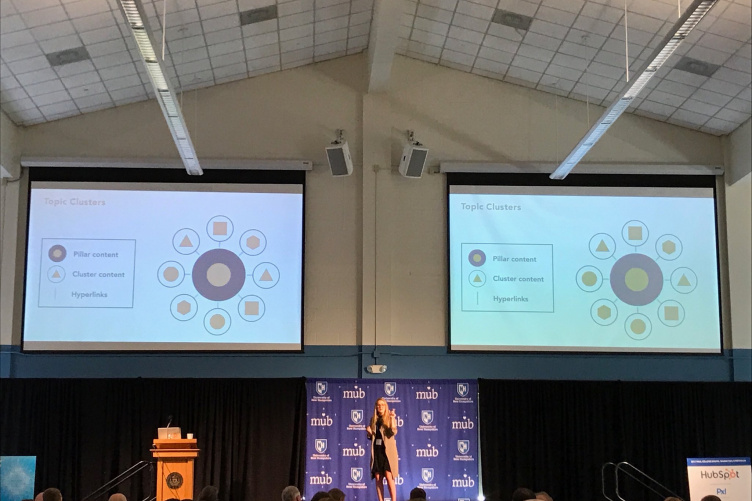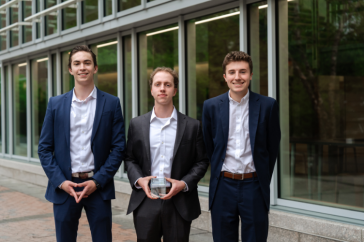
Lindsay Thibeault '09, of Hubspot, speaks to the 2017 Paul College Digital Marketing Symposium audience. Credit: Goksel Yalcinkaya.
Couldn't make it to this year's Digital Marketing Symposium? Take a peek at some of the highlights we compiled from this year's professionals.
People are obsessed with data instead of the business
“The problem is that we are obsessed about data and not the business,” said Jonathan O’Donnell, PixelMEDIA’s director of digital marketing. Marketers use data to track and analyze how a business is progressing, but may lack the knowledge to use the data to make decisions for their business.
Free educational marketing resources are available online
Companies like HubSpot and Wistia offer free digital marketing resources online. Wistia has a free resource library and a free video plugin tool called Soapbox. HubSpot offers HubSpot Academy, free marketing courses that teach the consumer specific marketing skills and award them with a HubSpot certification upon completion of the course. Some free HubSpot courses include Inbound Marketing, Content Marketing and Email Marketing. These courses cover topics that are not taught in colleges or universities but are extremely beneficial for marketers in the digital marketing industry today.
One-click purchases are currently a huge opportunity for online marketers
This past September, Amazon’s “one-click purchase” patent expired. This gives competitors and online marketers the opportunity to use this unique feature. Companies and marketers with online stores can apply this feature to their site to create an easier checkout experience for shoppers and increase profits.
Videos are a great way for potential clients to get to know you
No one enjoys cold calls, right? Jonah Silberg from Wistia encourages businesses to use a different method when going after potential clients. Wistia’s salespeople create short videos introducing themselves. They do this because it gives the potential client the chance to see and hear the salespeople beforehand, which has been shown to create a more comfortable and relaxed engagement between the client and sales teams.
Marketing needs to be more of a H2H industry than B2B
Catherine Daly of Hootsuite emphasized the importance of human interaction between businesses. Human to human relationships rather than business to business creates a more personal and comfortable relationship between businesses and their consumers.
Content Marketing is more effective than traditional marketing methods
“Content marketing costs 62% less than outbound marketing and generates three times more leads,” said Lindsay Thibeault ’09 of HubSpot. Outbound marketing, such as print, mail, television, or radio content is dying in the marketing industry. Content marketing, such as social media, blogs, and videos are a more effective way to reach consumers in today’s digital market.
Google is now about intent, not keywords
Thibeault ’09 also explained that search engines are now smart enough to recognize intent. Google tracks user’s digital footprints when they search on their search engine. Google uses this data to focus on being able to predict a user’s search intentions and understand their behavioral patterns to support the customer’s needs.
Metrics don't matter, but it all needs to be measured
Chris Getman '07 of Vital Design discussed how metrics such as brand awareness, social media followers/likes/shares, email open rates, engagement rates, etc. don’t really matter because they don’t actually make a business money. However, businesses do need to measure all of this. These types of metrics can be beneficial but they don’t particularly matter if the business isn’t making a profit. If a business tracks these types of metrics they can use it to guide them in a direction to increase ROI.
Silver surfers are adopting current marketing strategies
It’s no question that the world of digital marketing was introduced to a newer generation. But Daly points out that this isn’t stopping the older generation from understanding and applying these techniques to their businesses. Digital media may have been embedded into the lives of millennials and young professionals, but people of all ages are learning the way and using it in their everyday lives. Whether it’s for their own personal use or for businesses, older generations are adapting to new technologies and applying them in the workplace. Don’t count out the silver surfers!
Employees play a huge role in their business’s engagement
Statistics provided by Daly and Hootsuite:
- Content shared by employees sees 8 times more engagement than content share by the business itself
- Messages shared by employees see 24 times more re-shares than messages shared by the business itself
This goes back to the human interaction of marketing. If people see an actual person’s account sharing content, generally users are more willing to view and share. People like to interact with other people. If an employee tweets about an event their business is holding, that employee’s friends, family, followers may like or share the content because they are more comfortable interacting with their peer than a business itself, especially if the business is a large-scale company. People need to market to other people!
Crowdsourcing solutions can solve company problems
Siobhan Gibney Gomis of InnoCentive explained that businesses no longer have to stay in house to solve problems. Crowdsourcing problems is a great way for people outside of the company to provide insights on how to solve company problems and challenges. Anybody can solve a challenge posted on InnoCentive's website. InnoCentive works with the company to post a challenge and choose a cash reward, which is given to the person who best solves the company's challenge.
-
Written By:
Zachary Tavano | Peter T. Paul College of Business and Economics | zt1007@wildcats.unh.edu

















































